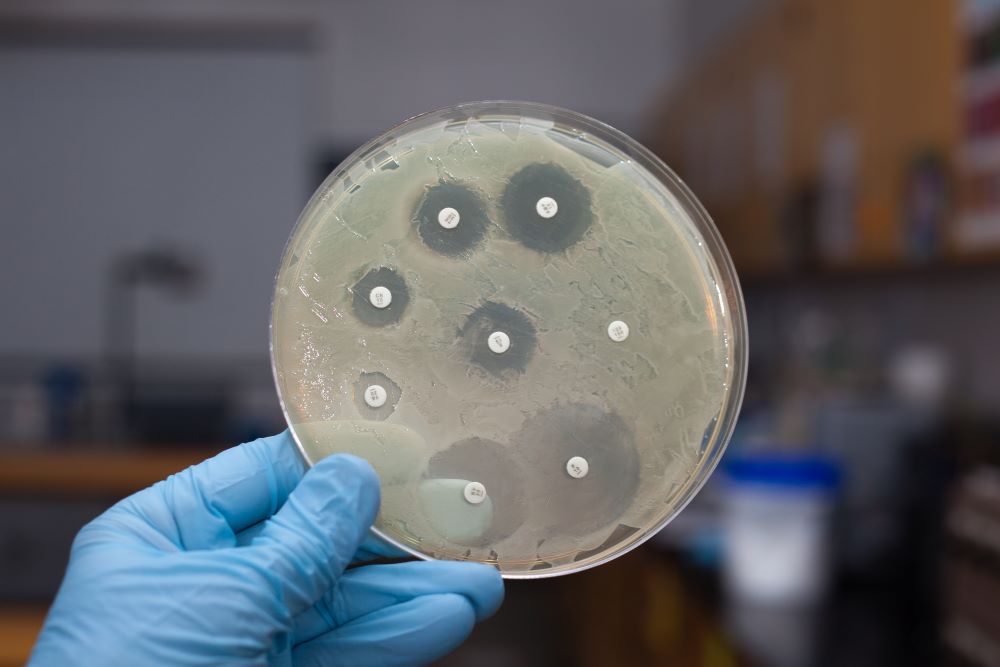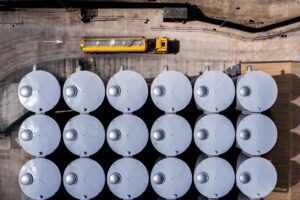As countries seek to boost renewable energy sources, biofuels have become an increasingly popular alternative to petroleum-based fuels. However, what many people don’t realize is that biofuels can be susceptible to microbial contamination that reduces quality and performance. The microbes that thrive in biofuel storage tanks feed on the organic compounds in fuels like biodiesel and ethanol, producing acids and other byproducts that corrode tanks and clog fuel lines. Left unaddressed, these microbial infestations can lead to costly repairs, tank failures, and compromised engine performance. In this blog you will be acknowledged about Preventing microbial growth in storage tanks. While biofuels offer an eco-friendly solution to meeting energy demands, you must implement proper microbial control strategies to ensure their stability and quality. By understanding how microbes contaminate biofuel tanks and the best ways to curb their growth, you can safeguard your investment in renewable energy.
Why Microbial Control Is Critical for Biofuel Quality
As biofuels become a larger part of the energy mix, ensuring their quality and preventing contamination is critical. Unchecked microbial growth in storage tanks can spoil biofuels, reducing their effectiveness and engine performance.
Why Controlling Microbes in fuel Matters
Microbes like bacteria, yeasts, and molds feed on the organic compounds in biofuels, breaking them down and producing waste products. Microbial such as bacteria in diesel fuel contamination can clog filters and fuel lines, corrode tanks, and produce acids that damage engine parts. The results are reduced efficiency, downtime, and repair costs.
Preventing microbial spoilage of storage tank
Best practices include for microbial growth removal:
- Regularly inspecting tanks for leaks or damage and repairing any issues immediately. This eliminates ways for microbes to enter the tank.
- Testing fuel samples to detect any microbial growth before it becomes an issue. Once contamination is detected, the affected fuel should be remediated or replaced.
- Storing biofuels in a cool, dry location away from sunlight. Warmer temperatures accelerate microbial growth.
- Ensure clean storage tanks , piping, and other equipment are properly cleaned and sanitized before use and between fuel batches. Any leftover residue provides nutrients for microbes.
- Adding biocides and stabilizers to biofuels in storage. These agents inhibit microbial growth and limit oxidation to maintain fuel quality. However, biocides must be compatible with the specific biofuel and any engine requirements.
By implementing best practices for controlling microbial growth, biofuel producers and users can avoid costly spoilage issues. With regular monitoring and preventative measures, high-quality, uncontaminated biofuels can be assured. Overall, effective microbial control is essential for optimizing biofuel usage and protecting infrastructure investments.
Common Microbes Found in Biofuel Tanks and Their Impact
To properly preserve biofuel quality and prevent microbial contamination in storage tanks, it is important to understand the common microbes that can spoil the fuel and their impact.
Yeasts and Molds
Yeasts and molds, such as Aspergillus spp. and Penicillium spp., require oxygen to grow and reproduce. They enter tanks through air vents and seals, and feed on the hydrocarbons and moisture in biofuels. These aerobic microbes produce organic acids that reduce pH, resulting in corrosion of tanks and pipelines. They also generate biomass that clogs filters and injectors.
Bacteria
Ever wonder how bacteria enter in fuel ? These bacteria enter tanks through contaminated water and sediments. Certain bacteria, such as Acinetobacter spp. and Pseudomonas spp., are facultative anaerobes that can thrive with or without oxygen. Under anaerobic conditions, bacteria break down hydrocarbons into organic acids, alcohols, and biomass. This leads to loss of heating value and lubricity in the fuel. Some bacteria also produce biosurfactants that emulsify hydrocarbons, while others generate biofilms that enable microbial aggregation and adhesion to surfaces.
By understanding the common contaminants and how they enter and spoil biofuels, proper prevention and control measures can be put in place. Routine tank inspections, moisture control, temperature regulation, and biocide treatments are critical for limiting microbial growth in biofuel storage tanks and safeguarding fuel quality. Implementing best practices in tank hygiene and fuel handling will help curb contamination issues that cost the biofuel industry millions each year.
Preventing microbial growth in storage tanks
Preventing microbial growth is critical for maintaining biofuel quality and avoiding contamination in storage tanks. As microbes feed on the hydrocarbons in biofuels, they produce acids and other byproducts that reduce pH, create sediment, and lead to corrosion of tank surfaces and piping.
Sanitation
Proper sanitation and hygiene are essential for controlling microbes. All equipment, piping, valves, and tanks should be thoroughly cleaned and sanitized before storing new biofuel. Any residual water or contaminants left behind can serve as food for microbes. Routine tank inspections and cleaning should also be performed, especially of tank floors and walls where sediment and water tend to collect.
Moisture Control
Microbes require water to grow and reproduce. Reducing moisture in tanks will limit microbial growth. This can be achieved through:
-Tightly sealing all tank openings, hatches, and vents to prevent outside air from entering. Ambient air contains moisture that can condense inside tanks.
-Installing a desiccant air dryer on any air vents or lines entering the tank. The dryer will remove moisture from the air before it enters the tank.
-Adding a biocide or stabilizing agent that reduces the amount of free water in the biofuel. These additives bind to water molecules, making the water unavailable for microbes to use.
Temperature Control
Increasing the temperature inside biofuel tanks will speed up microbial growth. Most microbes grow best in warm temperatures. Reducing tank temperatures when possible will slow their growth and reproduction. Some options for lowering temperatures include:
-Painting tank exteriors white or silver to reflect sunlight and heat.
-Insulating tank exteriors to prevent outside heat from warming the fuel inside.
-Circulating the biofuel or installing mixers/agitators to prevent temperature stratification inside the tank. Stagnant, warmer areas near the top of the tank promote microbial hotspots.
-For smaller tanks, you can install a refrigeration or cooling unit to actively lower temperatures.
By rigorously controlling moisture, sanitation, and temperature in biofuel storage tanks, operators can effectively limit the growth of microbes and prevent costly contamination issues. Consistent monitoring and maintenance are required to identify and address any lapses that could put biofuel quality and infrastructure at risk.
Best Practices for Biofuel Storage Tanks Microbial Monitoring
To maintain quality and prevent contamination in biofuel storage tanks, consistent microbial monitoring is critical. By routinely checking for microbes, you can detect issues early and take corrective actions.
It is recommended to test biofuel samples from storage tanks on a biweekly or monthly basis. Collect samples from multiple locations in the tank, including the top, middle and bottom. This provides a representative overview of the microbial population in the entire tank. Send the samples to an accredited laboratory for total microbial cell counts and identification of specific microbes present. Look for increases in total cell counts over time as well as the appearance of potential spoilage microorganisms like yeasts, molds, and bacteria.
If microbial levels start to rise or undesirable microbes are detected, intervene quickly. Options include biocides, filtration, temperature control, and tank cleaning. Biocides kill microbes directly but must be carefully monitored to avoid overuse. Filtration physically removes microbes but can be difficult to implement for large storage tanks. Controlling temperature, ideally keeping biofuel at or below room temperature, will slow microbial growth. Tank cleaning, while effective, requires draining and cleaning the entire tank, so should only be used when other options have failed or levels have become unacceptably high.
To maximize the effectiveness of your microbial monitoring program, train personnel on proper sample collection and handling techniques. Keep detailed records of all test results and actions taken. Review the data regularly to identify any ongoing issues and make improvements to prevent future contamination events. With vigilant monitoring and quick corrective responses, you can avoid costly damage to stored biofuels and maintain the highest product quality.
Conclusion
As you have seen, microbes pose a significant threat to biofuel quality and engine performance. Left unchecked, bacteria and fungi multiply rapidly in storage tanks and distribution systems, producing acids and biomass that degrade the fuel and clog filters and injectors. While microbes are ubiquitous in the environment, proper sanitation and biocide treatment can effectively limit their impact. By implementing a comprehensive microbial monitoring and control program, biofuel producers and distributors can safeguard their products, protect customers, and support the growing biofuel industry. Though often unseen, controlling these hidden invaders is critical to ensuring that biofuels achieve their full potential as a sustainable energy source. With vigilance and the right strategies in place, the threat from microbes can be neutralized
FAQs: Answers to Common Questions About Microbes in Biofuels
Many questions arise regarding the microbial contamination of biofuels. Here are some of the most frequently asked questions and their answers:
How do microbes enter biofuel tanks?
Microbial contamination often occurs during the initial filling of biofuel tanks. Bacteria, yeasts, and molds can enter through microscopic gaps or imperfections in tank seals, valves, pipes, and other equipment. These microbes then proliferate in the oxygen-rich environment at the top of the tank, the ullage space. As the biofuel is drawn out of the tank, microbes are mixed in, leading to spoilage. Proper sterilization and sanitation when constructing and filling tanks can help prevent this.
What types of microbes contaminate biofuels?
The microbes frequently found in biofuels include bacteria such as Bacillus, Clostridium, and Pseudomonas species; yeasts such as Candida spp.; and molds such as Aspergillus spp. These microbes thrive on the nutrients found in biofuels like fatty acids, sugars, and proteins. Some produce waste products that create unpleasant odors while others can form biofilms that clog filters and pipes.
Microbial growth detection method?
There are several methods used to detect microbes in biofuels:
- Culture-based methods: Growing microbe samples in petri dishes to visually identify colonies. Requires days to weeks for results.
- Microscopy: Viewing biofuel samples under a microscope to spot microbial cells. Only works for larger microbes and does not identify the species.
- Biochemical tests: Measuring chemicals like fatty acids, carbohydrates or proteins to infer microbial activity. Nonspecific and can be difficult to interpret.
- Molecular methods: Using techniques like polymerase chain reaction (PCR) to detect microbial DNA and RNA. Can identify microbes to the species level but requires advanced technical skills and equipment.
- Online monitors: Using sensors to continuously measure factors like dissolved oxygen, pH, and voltage changes to detect microbial growth in real-time. Still limited in the types of microbes they can identify.
By understanding how microbes enter biofuel tanks, the major groups involved, and available detection methods, biofuel producers and suppliers can take appropriate actions to test for, monitor, and remediate microbial contamination to ensure high quality and long shelf life of their products. Proactive microbial control helps prevent issues that could disrupt operations, damage customer relations, and require costly solutions.




